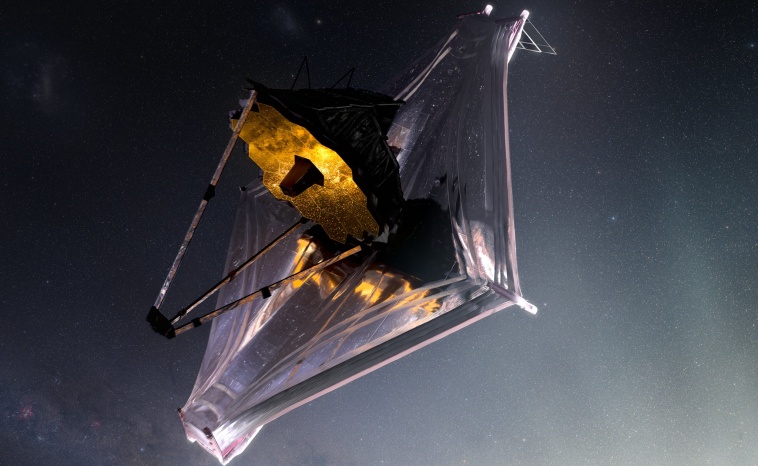Have We Just Found Signs of Life on Exoplanet K2-18b?
 Credits: Illustration: NASA, CSA, ESA, J. Olmsted (STScI), Science: N. Madhusudhan (Cambridge University)
Credits: Illustration: NASA, CSA, ESA, J. Olmsted (STScI), Science: N. Madhusudhan (Cambridge University)
After previously discovering water vapour on an exoplanet for the first time, scientists have finally been able to point the incredible James Webb Space Telescope at K2-18b – and the results are amazing! In this article, we’ll examine the findings and discuss what they could mean in the search for extraterrestrial life.
Imagine, if you will, a planet nearly nine times the size of our dear old Earth. It’s a place so far removed from our cosy corner of the universe that it’s been given the rather dry moniker of K2-18b. Doesn’t quite have the ring of ‘Earth’, does it? Nevertheless, this distant world may be harbouring something truly extraordinary: potential signs of life.
What Is K2-18b?

Credits: Illustration: NASA, CSA, ESA, J. Olmsted (STScI), Science: N. Madhusudhan (Cambridge University)
Credits: Illustration: NASA, CSA, ESA, J. Olmsted (STScI), Science: N. Madhusudhan (Cambridge University)K2-18b is an exoplanet located 124 light-years away from Earth. Discovered in 2015, this intriguing exoplanet orbits a red dwarf star named K2-18. It occupies a position within the star’s habitable zone, a heavenly sweet spot where conditions might be right for liquid water and life.
First spotted by NASA’s Kepler space telescope, the planet is over eight times the mass of Earth and is believed to be a water world, with estimates suggesting that up to 50% of its mass could be composed of water. This would be quite a departure from our home, where water makes up a somewhat more modest 0.02% of our planet’s total mass. But here’s where things get exciting. In 2019, an international team of astronomers detected water vapour in the planet’s atmosphere using the Hubble Space Telescope – the first time we’ve found water vapour on an exoplanet that’s orbiting in its star’s habitable zone. Indeed, the combination of water vapour and hydrogen discovered on K2-18b led to a new classification of exoplanet: Hycean planets.
What Are Hycean Planets?

Hycean planets, a portmanteau of “hydrogen” and “ocean”, represent a category of exoplanets that could potentially harbour life. These celestial bodies are typically larger than Earth but smaller than Neptune and are enveloped in a thick, hydrogen-rich atmosphere, possibly concealing a vast ocean beneath.
Astronomers initially thought that Hycean worlds were subject to relatively high atmospheric temperatures of up to 200 degrees Celsius, making it difficult to sustain life. However, evidence from K2-18b suggests that some Hycean planets may be able to maintain lower temperatures due to their thick hydrogen envelope, making them more conducive to habitability.
Confirmed Methane and Carbon Dioxide on K2-18b
Following the Hubble telescope’s intriguing observations, an international team of astronomers led by the prestigious University of Cambridge have completed a further study using the powerful James Webb Space Telescope (JWST) – and their findings offer us fascinating new insights. Using the JWST’s impressive spectral analysis capabilities, astronomers have successfully detected an abundant presence of methane and carbon dioxide in K2-18b’s atmosphere. Moreover, the proportions of these chemicals suggest that there could well be a water ocean beneath the planet’s thick hydrogen-heavy atmosphere, creating the fascinating possibility that the planet has all the right conditions to support some form of life.
A Scent of Something Special on K2-18b?

NASA, CSA, ESA, J. Olmstead (STScI), N. Madhusudhan (Cambridge University), CC BY 4.0, via Wikimedia Commons
Credits: Illustration: NASA, CSA, ESA, R. Crawford (STScI), J. Olmsted (STScI), Science: N. Madhusudhan (Cambridge University)In an even more curious development, the researchers may have also detected the presence of dimethyl sulphide (DMS) in the atmospheric composition of K2-18b. Why is this notable? Here on Earth, DMS is only produced by living organisms, primarily phytoplankton in marine environments. This fascinating discovery, if confirmed, could offer tantalising signs of extraterrestrial life forms on K2-18b.
A Dash of Caution
Before we allow our imagination to run wild with thoughts of extraterrestrial neighbours, it’s crucial to remember that the current detections are still provisional. Scientists will require additional data to validate the existence of DMS on K2-18b. It’s also possible that there could be another unknown, non-living producer of DMS. Nonetheless, the mere potential of such a discovery is enough to ignite a sense of excitement and wonder.
How Does the James Webb Space Telescope Analyse Exoplanet Atmospheres?

Credit: NASA GSFC/CIL/Adriana Manrique Gutierrez.
Credit: NASA GSFC/CIL/Adriana Manrique Gutierrez.The James Webb Space Telescope, our remarkable eye in the sky, is ingeniously designed to peer into the depths of the universe and unlock its most profound secrets. With its advanced spectral analysis capabilities, this extraordinary telescope can meticulously analyse the faintest traces of light that traverse through a planet’s atmosphere, enabling us to discern its intricate composition with unparalleled precision and accuracy.
It’s almost like possessing a cosmic chemistry set, where every observation and data point brings us closer to unravelling the enigmatic wonders and hidden mysteries of the cosmos. The remarkable findings and discoveries made so far through this awe-inspiring telescope have proven to be nothing short of utterly captivating and mind-boggling, igniting our curiosity and pushing the boundaries of our understanding of the vast and infinite universe that surrounds us.
A New Frontier
If confirmed, the discovery of life signs on K2-18b would be a monumental leap forward in our quest to find extraterrestrial life. It would open up a new frontier for study and exploration, raising many exciting questions. For instance, how does life on K2-18b compare to life on Earth? And what can this discovery tell us about our own place in the universe?
Perhaps one day, we’ll be able to say with certainty: We are not alone. But until we have an answer, the coming years will surely give us ever more exciting glimpses into the secrets of the universe. Until then, why not take the opportunity to learn more about the highlights of our galaxy with the OSR Star Finder App? Download the app to your iOS or Android smart device, and you’ll be able to discover, locate, and learn more about some of the famous stars, plants, and constellations in our galactic backyard!

